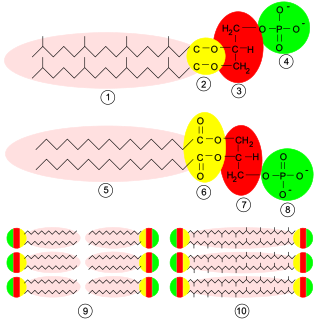
Lipids are a broad group of organic compounds which include fats, waxes, sterols, fat-soluble vitamins, monoglycerides, diglycerides, phospholipids, and others. The functions of lipids include storing energy, signaling, and acting as structural components of cell membranes. Lipids have applications in the cosmetic and food industries, and in nanotechnology.

A triglyceride is an ester derived from glycerol and three fatty acids. Triglycerides are the main constituents of body fat in humans and other vertebrates, as well as vegetable fat. They are also present in the blood to enable the bidirectional transference of adipose fat and blood glucose from the liver, and are a major component of human skin oils.

Glycerol, also called glycerine or glycerin, is a simple triol compound. It is a colorless, odorless, viscous liquid that is sweet-tasting and non-toxic. The glycerol backbone is found in lipids known as glycerides. Because it has antimicrobial and antiviral properties, it is widely used in wound and burn treatments approved by the U.S. Food and Drug Administration. Conversely, it is also used as a bacterial culture medium. Its presence in blood can be used as an effective marker to measure liver disease. It is also widely used as a sweetener in the food industry and as a humectant in pharmaceutical formulations. Because of its three hydroxyl groups, glycerol is miscible with water and is hygroscopic in nature.

Hexadecane (also called cetane) is an alkane hydrocarbon with the chemical formula C16H34. Hexadecane consists of a chain of 16 carbon atoms, with three hydrogen atoms bonded to the two end carbon atoms, and two hydrogens bonded to each of the 14 other carbon atoms.

Glycerophospholipids or phosphoglycerides are glycerol-based phospholipids. They are the main component of biological membranes in eukaryotic cells. They are a type of lipid, of which its composition affects membrane structure and properties. Two major classes are known: those for bacteria and eukaryotes and a separate family for archaea.

Shark liver oil is an oil obtained from the livers of sharks. It has been used for centuries as a folk remedy to promote the healing of wounds and as a remedy for respiratory tract and digestive system problems. It is still promoted as a dietary supplement, and additional claims have been made that it can treat other maladies such as cancer, HIV, radiation sickness, swine flu, and the common cold. To date, none of these claims has been medically validated and shark liver oil (alone) is not a medication prescribed or utilized by American physicians. However, it is a component of some moisturizing skin lotions and hemorrhoid medications.

Glycerophospholipids of biochemical relevance are divided into three subclasses based on the substitution present at the sn-1 position of the glycerol backbone: acyl, alkyl and alkenyl. Of these, the alkyl and alkenyl moiety in each case form an ether bond, which makes for two types of ether phospholipids, plasmanyl, and plasmenyl. Plasmalogens are plasmenyls with an ester linked lipid at the sn-2 position of the glycerol backbone, chemically designated 1-0(1Z-alkenyl)-2-acyl-glycerophospholipids. The lipid attached to the vinyl ether at sn-1 can be C16:0, C18:0, or C18:1, and the lipid attached to the acyl group at sn-2 can be C22:6 ω-3 or C20:4 ω-6, . Plasmalogens are classified according to their head group, mainly as PC plasmalogens (plasmenylcholines) and PE plasmalogens (plasmenylethalomines) Plasmalogens should not be confused with plasmanyls.

In biochemistry, an ether lipid refers to any lipid in which the lipid "tail" group is attached to the glycerol backbone via an ether bond at any position. In contrast, conventional glycerophospholipids and triglycerides are triesters. Structural types include:
Cetyl alcohol, also known as hexadecan-1-ol and palmityl alcohol, is a C-16 fatty alcohol with the formula CH3(CH2)15OH. At room temperature, cetyl alcohol takes the form of a waxy white solid or flakes. The name cetyl derives from the whale oil (cetacea oil, from Latin: cetus, lit. 'whale', from Ancient Greek: κῆτος, romanized: kētos, lit. 'huge fish') from which it was first isolated.

In organic chemistry an enol ether is an alkene with an alkoxy substituent. The general structure is R2C=CR-OR where R = H, alkyl or aryl. A common subfamily of enol ethers are vinyl ethers, with the formula ROCH=CH2. Important enol ethers include the reagent 3,4-dihydropyran and the monomers methyl vinyl ether and ethyl vinyl ether.

Monoglycerides are a class of glycerides which are composed of a molecule of glycerol linked to a fatty acid via an ester bond. As glycerol contains both primary and secondary alcohol groups two different types of monoglycerides may be formed; 1-monoacylglycerols where the fatty acid is attached to a primary alcohol, or a 2-monoacylglycerols where the fatty acid is attached to the secondary alcohol.

The Portuguese dogfish or Portuguese shark, is a species of sleeper shark of the family Somniosidae. This globally distributed species has been reported down to a depth of 3,675 m (12,057 ft), making it the deepest-living shark known. It inhabits lower continental slopes and abyssal plains, usually staying near the bottom. Stocky and dark brown in color, the Portuguese dogfish can be distinguished from similar-looking species by the small spines in front of its dorsal fins. Its dermal denticles are also unusual, resembling the scales of a bony fish. This species typically reaches 0.9–1 m (3.0–3.3 ft) in length; sharks in the Mediterranean Sea are much smaller and have distinct depth and food preferences.
Alkylglycerol monooxygenase (AGMO) is an enzyme that catalyzes the hydroxylation of alkylglycerols, a specific subclass of ether lipids. This enzyme was first described in 1964 as a pteridine-dependent ether lipid cleaving enzyme. In 2010 finally, the gene coding for alkylglycerol monooxygenase was discovered as transmembrane protein 195 (TMEM195) on chromosome 7. In analogy to the enzymes phenylalanine hydroxylase, tyrosine hydroxylase, tryptophan hydroxylase and nitric oxide synthase, alkylglycerol monooxygenase critically depends on the cofactor tetrahydrobiopterin and iron.

2-Arachidonyl glyceryl ether is a putative endocannabinoid discovered by Lumír Hanuš and colleagues at the Hebrew University of Jerusalem, Israel. It is an ether formed from the alcohol analog of arachidonic acid and glycerol. Its isolation from porcine brain and its structural elucidation and synthesis were described in 2001.
Archaeol is composed of two phytanyl chains linked to the sn-2 and sn-3 positions of glycerol. As its phosphate ester, it is a common component of the membranes of archaea.

sn-Glycerol 1-phosphate is the conjugate base of a phosphoric ester of glycerol. It is a component of ether lipids, which are common for archaea.

A diglyceride, or diacylglycerol (DAG), is a glyceride consisting of two fatty acid chains covalently bonded to a glycerol molecule through ester linkages. Two possible forms exist, 1,2-diacylglycerols and 1,3-diacylglycerols. Diglycerides are natural components of food fats, though minor in comparison to triglycerides. DAGs can act as surfactants and are commonly used as emulsifiers in processed foods. DAG-enriched oil has been investigated extensively as a fat substitute due to its ability to suppress the accumulation of body fat; with total annual sales of approximately USD 200 million in Japan since its introduction in the late 1990s till 2009.
Crenarchaeol is a glycerol biphytanes glycerol tetraether (GDGT) biological membrane lipid. Together with archaeol, crenarcheol comprises a major component of archaeal membranes. Archaeal membranes are distinct from those of bacteria and eukaryotes because they contain isoprenoid GDGTs instead of diacyl lipids, which are found in the other domains. It has been proposed that GDGT membrane lipids are an adaptation to the high temperatures present in the environments that are home to extremophile archaea
Batyl alcohol is an organic compound with the formula HOCH2CH(OH)CH2OC18H37. It is a colorless solid. Batyl alcohol is a monoether formed by condensation of stearyl alcohol with one of the two primary alcohol sites of glycerol. Together with S-selachyl alcohol and S-chimyl alcohol, S-batyl alcohol is a component of some lipid membranes.
Selachyl alcohol is an organic compound with the formula HOCH2CH(OH)CH2OC18H35. It is a colorless oil. Selachyl alcohol is a monoether formed by condensation of oleyl alcohol with one of the two primary alcohol sites of glycerol. Together with S-batyl alcohol and S-chimyl alcohol, S-selachyl alcohol is a component of some lipid membranes. It is found in the liver of the shark Centrophorus squamosus. The name selachyl is derived from a classification of sharks, the neoselachii. Like other glyceryl ethers, those derived from selachyl alcohol are not saponifiable.














